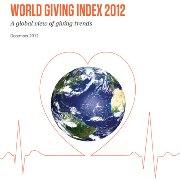World Giving Index 2012
World Giving Index and GDP
Few will be surprised that people are less inclined to donate money in a volatile economic climate. People might naturally be expected to adjust their giving according to their financial outlook. But a closer look at the data reveals a much less straight forward picture. Whilst as a general rule, people are more likely to give when they feel secure financially, the link between wealth and generosity is far from being a direct one . For instance, the highest proportion of the population donating money to charity was seen in the Republic of Ireland (79%), despite being ranked 15th in terms of Gross Domestic Product per capita (GDP) by the World Bank in 2011 and witnessing a well documented financial crisis in recent years. Luxembourg on the other hand, ranked 1st in terms of GDP, is ranked 19th in terms of prevalence of giving money to charity (56%).
So whilst economic trends can influence giving, it seems that other factors at play within each country have an equally determinate impact on philanthropy. Religion, for example, could be playing an important role in encouraging giving, with most religions having a form of tithing as a central tenet and with some having definitive expectations such as the practice of Zakat in Islam which requires those who can afford it to give a fixed proportion of their income to charitable causes. In the USA for example, according to the Giving Institute’s US Giving report, 32% of charitable donations went to religious organisations.image
Demographics are also likely to have a significant impact on giving. In terms of the global average, there does not appear to be a significant difference between the genders, with women giving 0.8% less than men globally. However, there are huge differences between countries. In Canada for example, 75% of women gave money to charity in the last month compared to just 53% of men, whereas 42% of Afghani men donated money compared to just 24% of women. Age, on the other hand, seems to be a much more stable predictor of philanthropy with people giving more as they age in almost every country – a barrier that CAF is already working to overcome in the UK through its Generation Gap Campaign.
Whilst addressing some of the above factors would require widespread societal change, there are other factors affecting giving that governments can more easily influence through specific policies. The recommendations in the World Giving Index are not a panacea for philanthropy but by offering achievable targets which address known factors affecting philanthropy, they are a useful starting point.
There is plenty more work to do in order to strengthen the evidence base for our recommendations and find ways of turning them into clear ‘asks’ to governments. CAF is in the process of putting together an exciting programme of work that will add value to the World Giving Index. By undertaking research and engaging people through our networks, we hope to be able to create a compelling advocacy resource for those who want to see the development of philanthropy worldwide.
In my next blog, I will look at the World Giving Index recommendations in more detail and explore how they relate to wider global trends.
Adam Pickering

